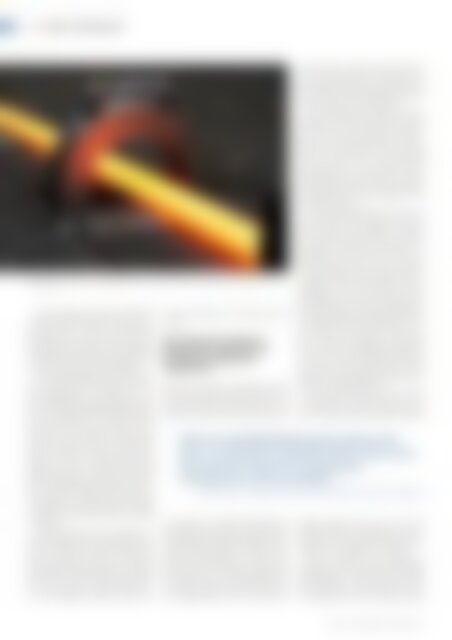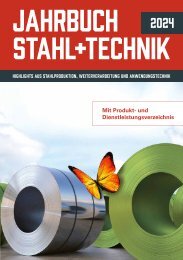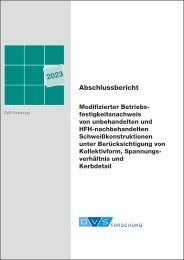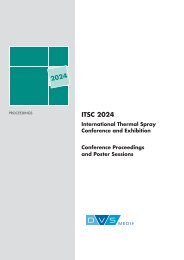STEEL + TECHNOLOGY 04/2019 EXTRACT
STEEL + TECHNOLOGY 04/2019 EXTRACT
STEEL + TECHNOLOGY 04/2019 EXTRACT
Create successful ePaper yourself
Turn your PDF publications into a flip-book with our unique Google optimized e-Paper software.
62 | <strong>STEEL</strong> <strong>TECHNOLOGY</strong><br />
The portable system CALIPRI RC220 can be used flexibly at different positions (Picture:<br />
Nextsense)<br />
Stahl Judenburg produces 70,000 tons<br />
of bright steel and steel with special profiles<br />
per year. In order to fulfil the high<br />
standards of the market, narrow tolerances<br />
are equally important as the high-quality<br />
feedstock of bars 100% quality-proofed<br />
for both, internal and external defects.<br />
The required precision for the production<br />
of bright steel components was further<br />
optimized by the utilization of the<br />
CALIPRI RC220 developed by Nextsense.<br />
Due to the patented CALIPRI technology<br />
the measurement of the rolled profile is<br />
performed with highest precision and<br />
within just a few seconds. The portable<br />
device is flexible in use and can be positioned<br />
at various measurement points<br />
along the bar mill. “With the CALIPRI<br />
RC220 sample testing has been considerably<br />
simplified while at the same time saving<br />
costs and increasing the transparency<br />
of processes”, says Peter Sammt, manager<br />
rolling mill and heat treatment at Stahl<br />
Judenburg.<br />
The pressing need for improvement in<br />
sample testing was the major decision factor<br />
to purchase the contactless and laserbased<br />
measurement device. “Previously,<br />
the testing was done by taking the sample<br />
directly from the production line to measure<br />
it with a caliper”, explains Peter Sammt.<br />
This traditional method is quite common<br />
but old-fashioned – wasting time and<br />
money.<br />
Hot rolled special profiles by<br />
Mannstaedt – developed and<br />
produced matching exact<br />
specifications<br />
Whenever customers need steel profiles<br />
with an extraordinary contour, they turn to<br />
the experts of Mannstaedt GmbH. For the<br />
rolling mill, precision is a matter of high-precise<br />
geometry individually developed and<br />
produced for the customer. Here, the product<br />
development differs vehemently compared<br />
to other industries. Innovation is not<br />
driven by Mannstaedt but rather by the<br />
market itself. The customer usually asks<br />
the rolling experts at Mannstaedt for a<br />
very special contour, the latter then develop<br />
a rollable profile. So, the company is<br />
informed about market trends quite early<br />
on and can provide very individual, customized<br />
solutions quickly. Two rolling mills<br />
can transform about 200,000 tonnes of<br />
steel annually into special profiles.<br />
One example for a special customer<br />
request is the individual profile of lift masts<br />
on forklift trucks. As soon as the customer<br />
plans a new product generation, Mannstaedt<br />
will be informed. Thus, the rolling<br />
mill can make sure the technological<br />
requirements for the production of this<br />
special profile can be met on time. Another<br />
example for special profiles produced<br />
by Mannstaedt are door hinges for the<br />
automotive industry.<br />
Be it individual profiles of lift masts for<br />
forklift trucks or door hinges for the automotive<br />
industry, the production process<br />
for the special profiles follows a certain<br />
procedure. “We heat the material – a<br />
square profile which we buy in. In several<br />
transformation steps it is then rolled into<br />
its special shape”, explains Martin Schütt,<br />
manager of one of the rolling mills at<br />
Mannstaedt. “It is here where we use the<br />
CALIPRI RC220”, adds his colleague Dr.<br />
Christian Trappmann, head of the calibration<br />
department at Mannstaedt and contact<br />
person for the technical customer support.<br />
“We use the gauge to check the<br />
contour after every rolling stand along the<br />
mill. Thus, the CALIPRI RC220 is mainly<br />
used when we first produce a profile. Additionally,<br />
the profile gauge helps us to configure<br />
our existing products.”<br />
But this doesn’t mean that the CALIPRI<br />
is rarely used – quite the contrary is the<br />
case. At Mannstaedt the product changes<br />
With the CALIPRI RC220 sample testing has<br />
been considerably simplified while at the same<br />
time saving costs and increasing the<br />
transparency of the processes<br />
Peter Sammt, manager rolling mill and heat treatment at Stahl Judenburg.<br />
happen several times a day. Thus, the<br />
CALIPRI RC220 is needed quite often.<br />
Apparently, it’s frequent use made the purchase<br />
of a second device necessary.<br />
Before CALIPRI was established,<br />
another product testing method was used<br />
at Mannstaedt – a very common method<br />
also widely used in other rolling mills. Product<br />
samples were cut off, cooled in a water<br />
<strong>STEEL</strong> + <strong>TECHNOLOGY</strong> 1 (<strong>2019</strong>) No. 4


















